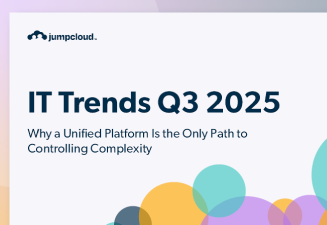As a CIO, your responsibilities are growing faster than ever. You need to secure more endpoints, support remote work, and cut operational costs. At the same time, your IT stack is likely more fragmented than ever.
To help navigate these challenges, JumpCloud surveyed over 800 IT leaders. The results point to one clear takeaway:
Unifying IT needs to be a top priority.
This is not just about improving efficiency. It is about protecting your organization, enabling innovation, and solidifying your leadership role. Unification delivers a range of benefits that can help you solve today’s challenges while preparing for what’s next.
Unification Reduces IT Complexity and Risk
The survey reveals that organizations rely on more than nine platforms to run their IT environments. These include identity systems, device managers, access controls, and security software.
The result is a tangled tech stack. It’s hard to maintain and even harder to secure. No wonder most (74%) IT leaders say their environment is too complex.
This complexity comes at a cost. Fragmented systems slow operations. They create blind spots, increase the risk of security incidents, and make compliance more difficult.
Tool sprawl also wastes time. IT teams spend hours switching between tools, fixing integration issues, and filling in gaps.
Unification offers a better approach. Consolidating platforms reduces friction and improves security through centralized control. Most importantly, it frees your team to focus on projects that drive the business forward.
Unification Transforms You Into a Strategic Leader
While only 19% of organizations have fully unified their IT stack, they are seeing stronger results across the board.
When you champion unification, you streamline infrastructure and elevate IT’s role in the business.
A unified environment allows your team to focus less on maintenance and more on innovation. Which directly contributes to strategic initiatives like AI adoption and employee experience.
It also gives you greater visibility across all devices, users, and platforms.
Whether your organization runs on Windows, macOS, Linux, or mobile platforms, unification brings everything under one roof.
There are various platforms out there that support one or maybe two [operating systems], but finding one that can support all three was huge.
– Mike Case, Senior IT Manager, Impel | Read The Case Study
Your AI Ambitions Depend on a Unified Foundation
Nearly every organization is exploring or adopting AI, with 46% ranking AI readiness as their top focus.
But with opportunity comes new risk. As AI tools spread across the enterprise, it becomes harder to monitor usage, control access, and safeguard data — especially in fragmented environments.
Shadow integrations, unmanaged bots, and disconnected data systems introduce vulnerabilities that traditional IT structures weren’t built to handle.
A unified IT foundation gives you the control and clarity needed to manage AI responsibly. It lets you:
- Monitor AI usage in real time.
- Apply consistent security policies across all users and systems.
- Ensure compliance and governance as your AI tools evolve.
Simply put, unification lays the groundwork for safe, scalable, and well-governed AI adoption.
Security Must Start with Unified Identity and Access
Today’s threats are increasingly centered on identity. Attackers are stealing credentials, hijacking sessions, and impersonating users.
Nearly half of the organizations say identity-based threats are their number one concern heading into 2026. Despite this, only 11% of organizations have implemented a full Zero Trust model.
This creates a major opportunity for you to lead.
By unifying identity and device management, you can:
- Enable secure single sign-on across all tools.
- Reduce password-related security incidents.
- Gain full visibility into who is accessing what, from where, and on which device.
With new data privacy regulations emerging worldwide, you must show that your organization can protect sensitive information across complex, distributed environments.
Unification Helps You Optimize Spending and Maximize Value
IT leaders continue to face growing pressure to do more with less. Budgets remain tight, yet expectations for modernization and innovation haven’t slowed.
That’s why more than half of organizations are prioritizing cost optimization this year.
At the same time, 54% are increasing their investments in IT unification and automation. Far from being a contradiction, this reflects a smarter, more strategic approach to value creation.
Tool consolidation has emerged as a top priority.
By unifying your IT stack, you can reduce licensing costs, simplify vendor management, and eliminate redundant tools. The result is a leaner, more agile environment that improves user experience and frees up resources.
You Are Asked to Lead. Unification Helps You Deliver.
As a CIO, your role is no longer limited to keeping systems operational. You’re now expected to drive innovation, lead digital transformation, and guide your organization through constant change.
Unifying your IT stack is one of the most effective ways to deliver on those expectations. It reduces the noise of day-to-day maintenance, giving you and your team the freedom to focus on strategic priorities. It also shifts IT from a reactive support function to a proactive growth engine.
The message is clear: delaying unification puts your organization at risk. Fragmented systems slow you down. They increase vulnerabilities and make it harder to scale AI, secure data, and prove IT’s strategic value.
Act now, and you’ll gain the clarity, control, and flexibility you need to lead with confidence.
The opportunity is clear. The moment is now. It’s time to unify. Download the Q3 2025 IT Trends Report to learn more.





